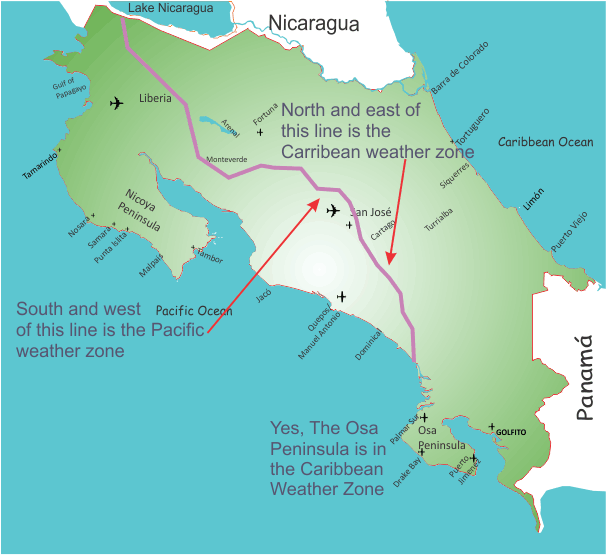Respected Leader for Costa Rica Adventure & Nature Vacations Since 1991
All other countries: +506 4001-3860
Costa Rica Weather and Climate

Sometimes rainy, sometimes sunny, always fun
Weather: With Two Great Oceans - and only 1 Small Country Between Them

Click on map for enlarged view of weather division of Costa Rica
Tropical Life Has Advantages
Even though Costa Rica is only between 8 and 13 degrees above the equator, Costa Rica is much more "temperate" than most North American locations. Costa Rica is cooled by two oceans and no matter where you are in Costa Rica, you are always within 80 miles of a coast. A typical day starts out about 65 degrees Fahrenheit, gets up to mid 80's, then starts dropping before sunset. Days are 12 hours (plus or minus 30 minutes) year round, so there are no long, hot afternoons. The Pacific beaches are warmer and the sun is intense in the dry season (mid December through mid April). The central highlands (about 4,000 ft. altitude), where 80% of the population lives, are cool enough during the day that almost none of the residents have air conditioning. Nights are warm enough that no almost one has a heating source.
Rain
Yes, we have rain! but we have a very different style of rain in the equatorial region compared to that which falls in large parts of the U.S. Our rain comes mainly from low clouds, rather than melting ice crystals, so it is surprisingly warm. Serendipity rarely cancels activities because of rain -- there's nothing quite so wonderful as riding a horse in pouring rain, unless it's riding a bike, or hiking in the jungle, or, best of all, rafting a whitewater river. About the only activity we cancel because of rain is ballooning.
Rainy Season
The two distinct weather zones are more or less determined by the Continental Divide.
The Central Valley and Pacific
San Jose and the Pacific beaches are in the Pacific zone. While San José's altitude keeps it cooler, the beaches get very hot in dry season, December through April. From late April through mid June is a short, mild rainy season, with showers normally beginning late in the day. September through November is a REAL rainy season, with intense rains and often morning rain, but certainly rain every day.
The Caribbean
The central mountain range (including Arenal, Poás, Irazú, and Turrialba volcanoes) creates the Continental divide, and everything "north" and "east" of the range is in the Caribbean zone. The Caribbean zone includes all the lushness normally shown in photos of Costa Rica -- magnificent rain forests, cloud forests, waterfalls, misty mountains, true wild jungle. It's home to the best rafting, hiking, canyoning, horseback, and small, interesting towns and, of course, the very active volcanoes. The Caribbean (Atlantic) weather zone has rain more evenly spread year-round, but (hopefully!!) rain every day or two. Without the daily afternoon rain, the green would turn brown, the rivers would go dry, and the waterfalls disappear.... which is what happens in the Pacific zone during dry season.
Tropical Storms
Unlike weather systems that travel across the United States, the weather here does not get pushed along by frontal systems (like the Jet Stream pushes big storms into the Midwest from western Canada in the winter, or hurricanes drive big rains and tornadoes all along the eastern half of the U.S. in summer). That's the good news.
The bad news is that there are storms (we call them temporals) that form "right over your head". And the storm stays right over your head sometimes 2-5 days -- there's no jet stream to push it out. When do we get temporals? Completely unpredictable; they can, and do, happen year round, usually 2 or 3 occur each year in each area of the country. Interestingly you can usually find some place in the country that is free of the storm. Sometimes just cross the Continental Divide and and you'll be out of a "temporal". Or into one.
Thunder and Lightning and Rainstorms
Big storms are magnificent, and huge in the tropics. There's lightening -- and constant, often deafeningly hard, rain. And little wind. These storms happen a lot -- as seasons start to change they will happen every day, usually just about 3-4 in the afternoon (peak heating from the sun).
Hurricanes
Even though Costa Rica is in the Caribbean, because Costa Rica is so far south it is very rare that a hurricane strikes land over Costa Rica.